(单词翻译:单击)
5.Sacsayhuaman
5.萨克塞瓦曼
Not far from the famous Inca city of Machu Picchu lies Sacsayhuaman, a strange embankment of stone walls located just outside of Cuzco. The series of three walls was assembled from massive 200-ton blocks of rock and limestone, and they are arranged in a zigzag pattern along the hillside. The longest is roughly 1000 feet in length and each stands some fifteen feet tall. The monument is in astonishingly good condition for its age, especially considering the region's propensity for earthquakes, but the tops of the walls are somewhat demolished, as the monument was plundered by the Spanish to build churches in Cuzco. The area surrounding the monument has been found to be the source of several underground catacombs called chincanas, which were supposedly used as connecting passageways to other Inca structures in the area.
萨克塞瓦曼——由奇怪的石头墙组成的堤岸,位于距离著名的印加城马丘比丘不远的库斯科市外。这成系列的三道墙由许多重达200吨的岩石和石灰岩组成,沿着山腰呈锯齿形排开。最长的一个大约1000英尺,高均为大约15英尺。这个遗址存在之久、保存之完好,令人惊讶,尤其是考虑到其位于地震多发带。但是,墙体的顶部不同程度地遭到破坏,因为西班牙人曾掠夺石块用来在库斯科建造教堂。人们发现萨克塞瓦曼的周边地区是数个地下墓穴的源头,这些墓穴是女奇卡诺人的。人们推测它是连接此地区其他印加建筑的通道。
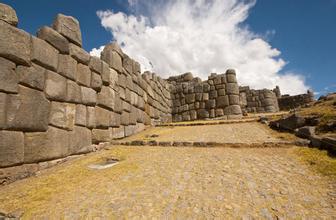
The Mystery
谜团
Most scientists agree that Sacsayhuaman served as a kind of fortress of barrier wall, but this has been disputed. The strange shape and angles of the wall have led some speculate that it may have had a more symbolic function, one example being that the wall, when seen next to Cuzco from above, forms the shape of the head of a Cougar. Even more mysterious than the monument's use, though, are the methods that were used in its construction. Like most Inca stone works, Sacsayhuaman was built with large stones that fit together so perfectly that not even a sheet of paper can be placed in the gaps between them. Just how the Incas managed such expert placements, or, for that matter, how they managed to transport and lift the heavy hunks of stone, is still not fully known.
科学家们一致认为萨克塞瓦曼曾被用作围墙的堡垒,但是仍然有人质疑。这个墙的奇怪形状和棱角使人们推测也许它具有更多象征作用,其中一个例子就是站在库斯科边界俯瞰墙体,它看起来像一头美洲狮。相比它的用途,更神秘的是这些墙是如何建造的。如众多的石制品一样,萨克塞瓦曼也是由巨大的石块完美地契合而成,石块之间拼接得如此天衣无缝,甚至连一张纸也塞不进去。至于印加人如何创造出如此杰作,或者说,他们是如何将那么巨大的石块搬运堆砌起来,仍然是个不解之谜。
4.The Easter Island Moai
4.复活岛的摩埃石像
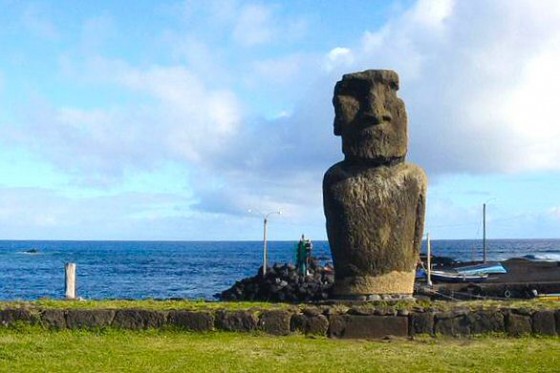
One of the most iconic series of monuments in the Pacific islands is the Moai, a group of huge statues of exaggerated human figures that are found only on the small, isolated island of Rapa Nui, or Easter Island. The Moai were carved sometime between 1250 and 1500 AD by the island's earliest inhabitants, and are believed to depict the people's ancestors, who in their culture were held in the same regard as deities. The Moai were chiseled and carved from tuff, a volcanic rock that is prevalent on the island, and they all feature the same characteristics of an oversized head, broad nose, and a mysterious, indecipherable facial expression. Scientists have determined that as many as 887 of the statues were originally carved, but years of infighting among the island's clans led to many being destroyed. Today, only 394 are still standing, the largest of which is 30 feet tall and weighs over 70 tons.
摩埃石像是太平洋岛屿上一系列最具标志性的遗迹之一,它是一组巨大的夸张的人物雕像,人们在一个叫拉帕努伊小孤岛(Rapa Nui),也称复活岛上发现了它。摩埃石像是由该岛最早期居民于公元1250年至1500年间雕刻而成。人们认为,摩埃石描绘的是该岛最早期居民的祖先,他们的文化视其祖先为神灵。摩埃石像是用岛上常见的的凝灰岩和火山岩刻雕刻而成。它们都具有相同的特征,即超大的头部,宽大的鼻子和神秘的难以辨认的面部表情。科学家们认为,起初雕刻的数量有887座之多,但多年的岛上部落的内讧致使很多石像遭破坏。如今,只剩下394座,最大的一个有30英尺高,70多吨重。
The Mystery
谜团
While there is a fairly solid consensus on why the Moai were erected, how the islanders did it is still up for debate. The average Moai weighs several tons, and for years scientists were at a loss to describe how the monuments were transported from Rano Raraku, where most of them were constructed, to their various locations around the island. In recent years, the most popular theory is that the builders used wooden sleds and log rollers to move the Moai, an answer that would also explain how the once verdant island became almost totally barren due to deforestation.
对于为什么竖立摩埃石像,人们达成了广泛的共识;但是,对于岛上居民是怎样做到的,人们还是争论不休。摩埃石像平均重达数吨,多年来科学家仍然无法得知摩埃石像是如何从拉诺拉拉库(Rano Raraku)——摩埃石像的生产基地——运到岛上各处的。近年来,被广为接受的理论是,建造者们用木制的雪橇和圆木移动摩埃石像,砍伐森林这一说法也解释了该岛由茂密的森林变为不毛之地的原因。
3.The Georgia Guidestones
3.佐治亚引导石
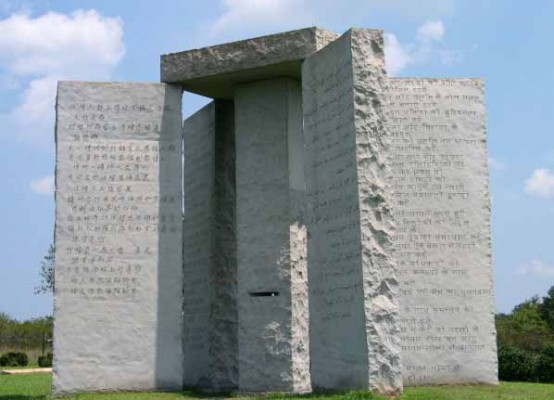
While most of the mysterious monuments on this list only became that way as centuries passed, the Georgia Guidestones, also known as American Stonehenge, are one landmark that was always intended to be an enigma. The monument, which consists of four monolithic slabs of granite that support a single capstone, was commissioned in 1979 by a man who went by the pseudonym of R.C. Christian. A local mason carefully crafted it so that one slot in the stones is aligned with the sun on the solstices and equinoxes, and one small hole is always pointed in the direction of the North Star. Most interesting, though, are the inscriptions on the slabs, which an accompanying plaque describes as "the guidestones to an Age of Reason." In eight different languages, the slabs offer a strange ten-point plan to ensure peace on Earth that includes vague proclamations like "prize truth–beauty–love–seeking harmony with the infinite," to very specific commands like "maintain humanity under 500,000,000 in perpetual balance with nature." Comments like this one have made the Guidestones one of the most controversial landmarks in the United States, and they have long been protested and even vandalized by groups that would like to see them demolished.
本榜单上的大部分遗迹都是因为数个世纪的洗礼而变得神秘。佐治亚引导石,又被称为美国版的巨石阵,是一个令人费解的地标性建筑。佐治亚引导石于1979年由一位化名R·C·克里斯蒂安的人委托建造,由四块巨大的厚板花岗岩支撑一块顶板组成。为了让石头的狭缝对齐在二至点和二分点的太阳,一个小小的洞总是指向北极星的方向,一位当地的石匠对此精雕细琢。然而,最有趣的是石板上所刻的文字——"一个理性时代的引导石"。石板用八种语言提出了奇怪的10条计划,这10条计划旨在保护世界和平,它包括模糊的宣言,类似于"珍视真—美—爱—寻求宇宙和谐",也包括非常具体的表述" 将人口控制在5亿以内,以保持人与自然界的平衡"。这样的表述让佐治亚引导石成为美国最受争议的地标建筑之一。一些人在抗议,甚至组织志愿者对其进行破坏。
The Mystery
谜团
For all their controversy, very little is known about who built the Guidestones or what their true purpose is. R.C. Christian claimed he represented an independent organization when he commissioned the landmark, but neither he nor his group has spoken up since its construction. Since the monument was built during the height of the Cold War, one popular theory about the group's intentions is that the Guidestones were to serve as a primer for how to rebuild society in the aftermath of a nuclear holocaust.
对于一切争论,即是何人建造的引导石,建造者的真正目的又是什么,这些很少有人知道。R·C·克里斯蒂安声称,在委托修建引导石的时候,他代表一个独立的组织。但是,引导石建好后,R·C·克里斯蒂安和他的组织并没有说明修建的目的。引导石是在冷战最紧张的时期而修建的,对于修建的目的,一个主流的观点就是,引导石将在核灾难后引导如何重建这个世界。
2.The Great Sphinx of Giza
2.狮身人面像
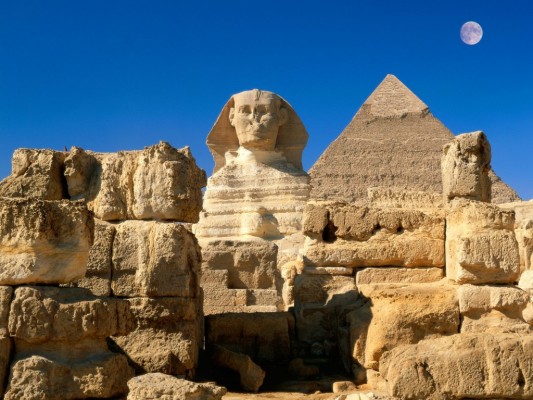
Sphinxes are massive stone statues that depict the body of a reclining lion with the head and face of a human. The figures are found all over the world in different forms, but they are most commonly linked with Egypt, which features the most famous example in the form of the Great Sphinx of Giza. Incredibly, the statue is carved out of one monolithic piece of rock, and at 240 feet long, 20 feet wide, and 66 feet tall, it is considered to be the biggest monument of its kind in the world. Historians largely accept the function of the Sphinx to have been that of a symbolic guardian, since the statues were strategically placed around important structures like temples, tombs, and pyramids. The Great Sphinx of Giza appears to be no different. It stands adjacent to the pyramid of the pharaoh Khafra, and most archeologists believe that it is his face that is depicted on that of the statue.
斯芬克斯(也称狮身人面像)是一些巨石雕像,它们有着倾斜的狮身和人的头像。世界各地都发现了这类雕像,形态各异。然而说到狮身人面像,人们主要想到的还是埃及,那里有最著名的狮身人面像。令人难以置信的是这座雕像是在一整块巨石上雕成的,其长240英尺,宽20英尺,高66英尺。因此也被看做是世界上最大的狮身人面像。历史学家普遍认为,因为狮身人面像的位置在庙宇、墓穴和金字塔这些重要建筑物周围,非常考究,所以狮身人面像是象征意义上的守护者。狮身人面像似乎也没有什么特别的。它就在哈夫尔法老(the pharaoh Khafra)的金子塔附近。多数考古学家认为,狮身人面像的脸实际就是哈夫尔法老自己的脸。
The Mystery
谜团
Despite its reputation as one of the most famous monuments of antiquity, there is still very little known about the Great Sphinx of Giza. Egyptologists might have a small understanding of why the statue was built, but when, how, and by who is still shrouded in mystery. The pharaoh Khafra is the main suspect, which would date the structure back to around 2500 BC, but other scientists have argued that evidence of water erosion of the statue suggests that it is much older and perhaps even predated the dynastic era of the Egyptians. This theory has few modern adherents, but if true it would mean the Great Sphinx of Giza is even more mysterious than previously believed.
尽管狮身人面像作为世界上最古老的雕像之一而享誉世界,但是世人对它仍知之甚少。埃及古物学者可能对建造的原因略知一二,但是,修建的时间、修建的方法以及由谁主持修建仍然是个迷。最可能的建造者可以追溯到公元前2500年的哈夫尔法老。但是其他的科学家认为雕像上有水侵蚀的迹象表明,建造的时间还要更早,或许可以追溯到埃及王朝那个时代。现代人很少有人支持这一理论,但如果事实果真如此,这将意味着狮身人面像要比我们之前想象的还要神秘。
1.Stonehenge
1.巨石阵
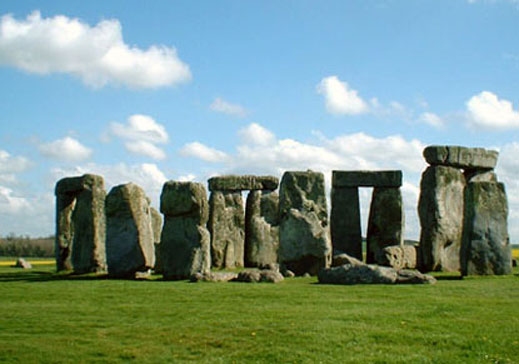
Of all the world's famous monuments, none has gained as much of a reputation for pure, simple mystery as Stonehenge. Stonehenge has been inspiring debate among scholars, scientists, and historians since the Middle Ages. Located in the English countryside, the landmark is believed to date back to 2500 BC, and consists of several mammoth pieces of rock arranged and piled on top of one another in what appears at first to be a random design. The site is surrounded by a small, circular ditch, and is flanked by burial mounds on all sides. Although the rock formations that still remain are undoubtedly impressive, it is thought that the modern version of Stonehenge is only a small remnant of a much larger monument that was damaged with the passing of time, and it is largely believed that the building process was so extensive that it could have lasted on and off for anywhere from 1500 to 7000 years.
世界所有著名的遗址中,没有哪个能像巨石阵般单单因其纯粹和神秘获得举世瞩目。自中世纪以来,巨石阵便一直引发学者、科学家和历史学家们的讨论。巨石阵坐落于英国的一个小村庄,它可以追溯到公元前2500年。这些巨大的石头一个个的堆砌起来,看似一种不经意的设计。巨石阵周围环绕着一条细小的圆形沟渠,同时四周还有些许坟丘环绕。毋庸置疑,巨石阵遗迹令人震撼,但是人们认为现存的巨石阵只是那些随着时间流逝而消失的大规模石头遗址的一小部分。人们普遍认为,建造的程序非常宏大,断断续续有1500至1700年的时间。
The Mystery
谜团
Stonehenge has become renowned for puzzling even the most brilliant researchers, and over the years the many gaps in the history of its construction, the nature of its use, and the true identity of its builders have become known as "The Mystery of Stonehenge." The Neolithic people who built the monument left behind no written records, so scientists can only base their theories on the meager evidence that exists at the site. This has led to wild speculation that the monument was left by aliens, or that it was built by some eons-old society of technologically advanced super-humans. All craziness aside, the most common explanation remains that Stonehenge served as some kind of graveyard monument that played a role in the builders' version of the afterlife, a claim that is backed up by its proximity to several hundred burial mounds. Yet another theory suggests that the site was a place for spiritual healing and the worship of long dead ancestors.
巨石阵因其自身的谜团而举世闻名,即便是最资深的研究人员也无法解开谜团。多年来,其建造的历史、用途、以及建造者的真实身份仍然不详,被统称为"巨石阵之谜"。新石器时代的人们建造巨石阵,但是没有留下文字记录,因此科学家们只能把他们的理论建立在现存遗址上那星星点点的证据之上。而这就引起了大家广泛的猜想:巨石阵是外星生物遗留下的;或者是远古社会所建,而他们的科技远超人类的文明。不考虑这些奇怪的想法,在这些所有的猜测中,最让人容易接受的解释是巨石阵是一种墓地专用的纪念碑,意味着建造者的来世,这一说法也因巨石阵周围的众多坟丘的证明而得到很多人的认同。然而,另一个理论认为,巨石阵是精神的治疗中心以及祭拜祖先之地。
翻译:风舞落月8+7 来源:前十网


